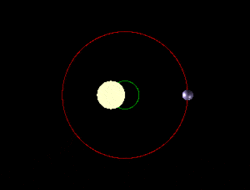Create a free profile to get unlimited access to exclusive videos, sweepstakes, and more!
A tug on binary stars reveals the mass of the Tatooine-like planet Kepler-16b
May the force of gravity be with you.

It’s not Tatooine, but it’s kinda close. More like an Ohann or Adriana.
Those are fictional gas giants orbiting the binary suns Tatoo I and II in Star Wars, the stars made famous by Luke Skywalker wistfully watching them set as the desert wind blew through his 1970s hair.
But there are planets like that in real life. The very first ever discovered was PSR B1620-26b, a planet orbiting a binary consisting of a pulsar and a white dwarf. Those are previously dead stars, which is cool, but not as satisfying perhaps as finding one orbiting Sun-like stars.
The first like that ever found was Kepler-16b, which is 275 light years from Earth. Discovered in 2011, it’s what’s called a circumbinary planet, meaning it orbits both stars simultaneously. The stars are similar to the Sun, though lower mass and cooler. One, called Kepler-16A, is a K-type, about 0.65 times the Sun’s mass and about 1/7th the Sun’s brightness. The other, Kepler-16B, is a red dwarf, only 1/5th the Sun’s mass and less than 1% as bright. The two stars orbit each other at a distance of about 33 million kilometers, taking 41 days to do so.
The planet is technically called Kepler-16(AB)b, but everyone calls it Kepler-16b for short. It was discovered using the transit method: We see its orbit almost exactly edge-on, so it passes directly in front of the two stars. When it does it creates a mini-eclipse, blocking a bit of the starlight. The amount of light blocked tells us the size of the planet, and Kepler-16b is about ¾ as big as Jupiter, so slightly smaller than Saturn. It orbits the stars every 229 days, about 100 million miles out. That’s about the same distance as Venus from the Sun, but because the two stars in the binary are so much cooler than the Sun, the temperature of Kepler-16b is likely quite cold, more like Mars.
But what is its mass? That’s the key datum; when we know the size and the mass we can determine the density, and that tells us what the planet is made of. Gas giants are very low density, iceworlds more, rocky even more yet, and planets like Earth with lots of iron are quite dense.
One way to find that is to use a different method called the radial velocity method. A planet and its host star orbit their center of mass, with the lighter planet traveling on a big orbit and the star a smaller one. As the star moves, its light gets Doppler shifted, shortening the wavelength as it approaches us and lengthening as it recedes. This can be measured, and in fact was how the very first few planets were found in the early 1990s.
That’s a lot harder to do with binary stars. Separating out the two signals is very tough, and the complicating planet signal is weak. Until now, it’s never been done before.
But astronomers have announced they have indeed made this measurement [link to paper]. It wasn’t easy, but it was possible. In this case, they had an advantage: The smaller of the two stars is so faint that its light hardly affects what we see from the system. The velocity effects of the two stars orbiting each other can be easily seen in the light from the brighter one, but the other star doesn’t contribute any real light. That made the planetary signal far easier to spot.
When they did the math, they found the mass of the planet is 0.313 ± 0.039 times the mass of Jupiter. That’s roughly 10 times the mass of Earth, or a bit less than Saturn. A hefty world. But its density is just a hair less than that of water, meaning it must be a gas giant. Jupiter has a similar density, for example.
To be fair, the mass of the planet was measured before, using a different method. We see the orbit of the two stars edge-on as well, so they eclipse each other. The timing of these eclipses is easy to measure. But, as it orbits, the gravity of the planet tugs on the two stars, changing that timing. From that the mass can be estimated, and was found to be… about 0.3 times Jupiter’s mass. Nice. The two methods agree! That gives us some confidence that this is all being done correctly.
The beauty of this is that it shows the method works. And they were able to measure the planet’s orbital velocity down to a very small uncertainty of just 1.5 meters per second — about the same as a brisk walking pace — which means they can find much lower mass planets, possibly even to about twice the mass of Earth, and we know a lot of such planets — called “super-Earths” — exist. We don’t know if any orbit binary stars, though, so that would be quite a discovery.
All the circumbinary planets found so far are gas giants, so no Tatooine yet. But we’re getting closer all the time.





























